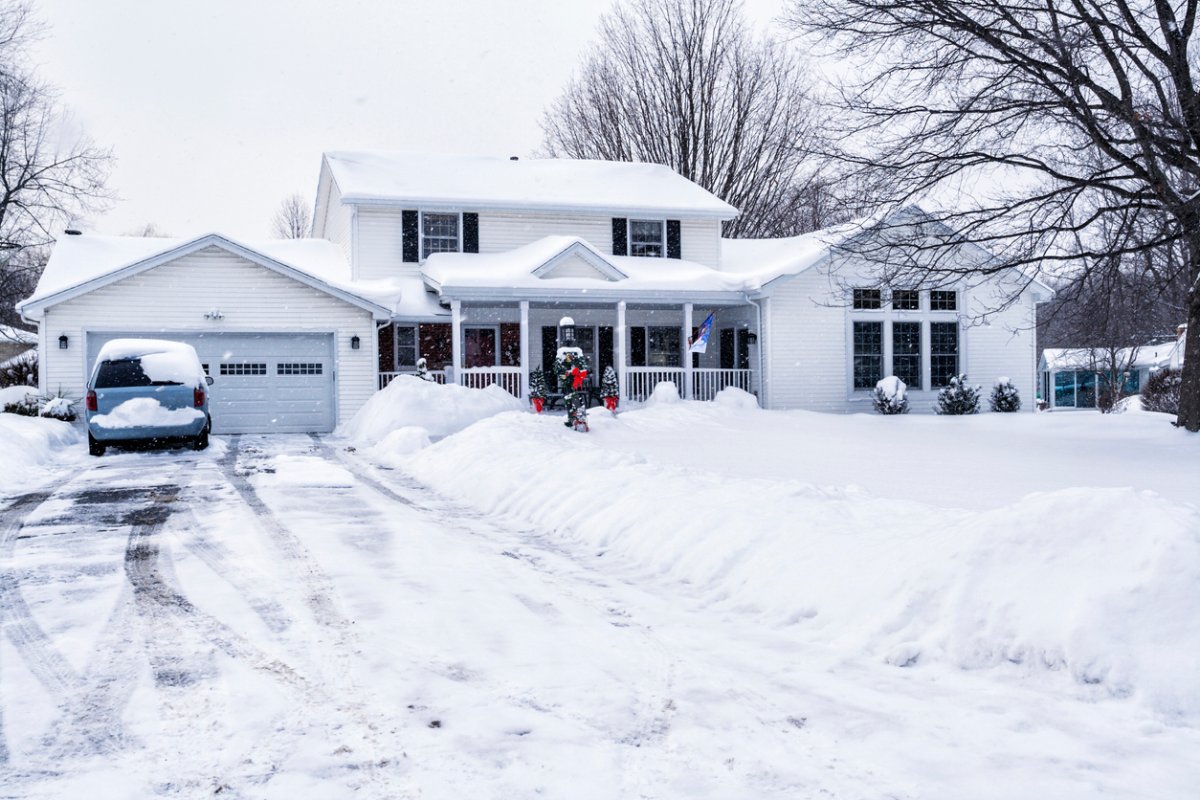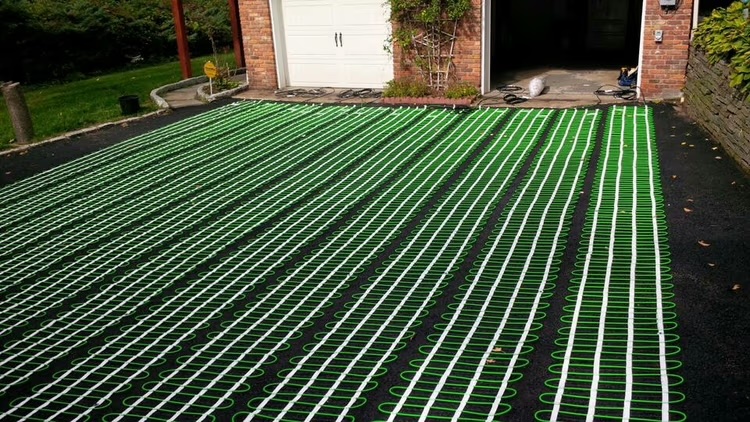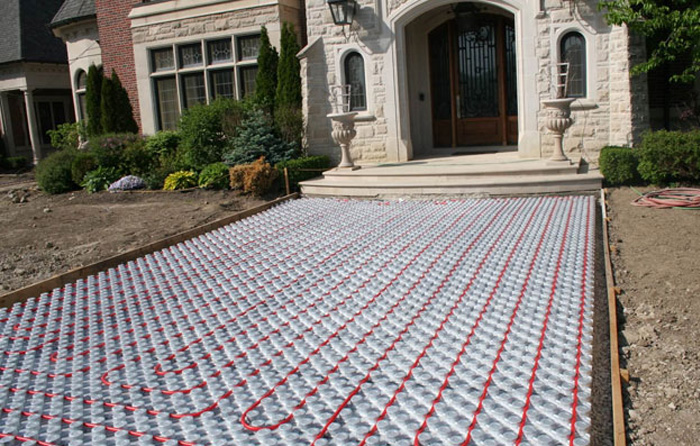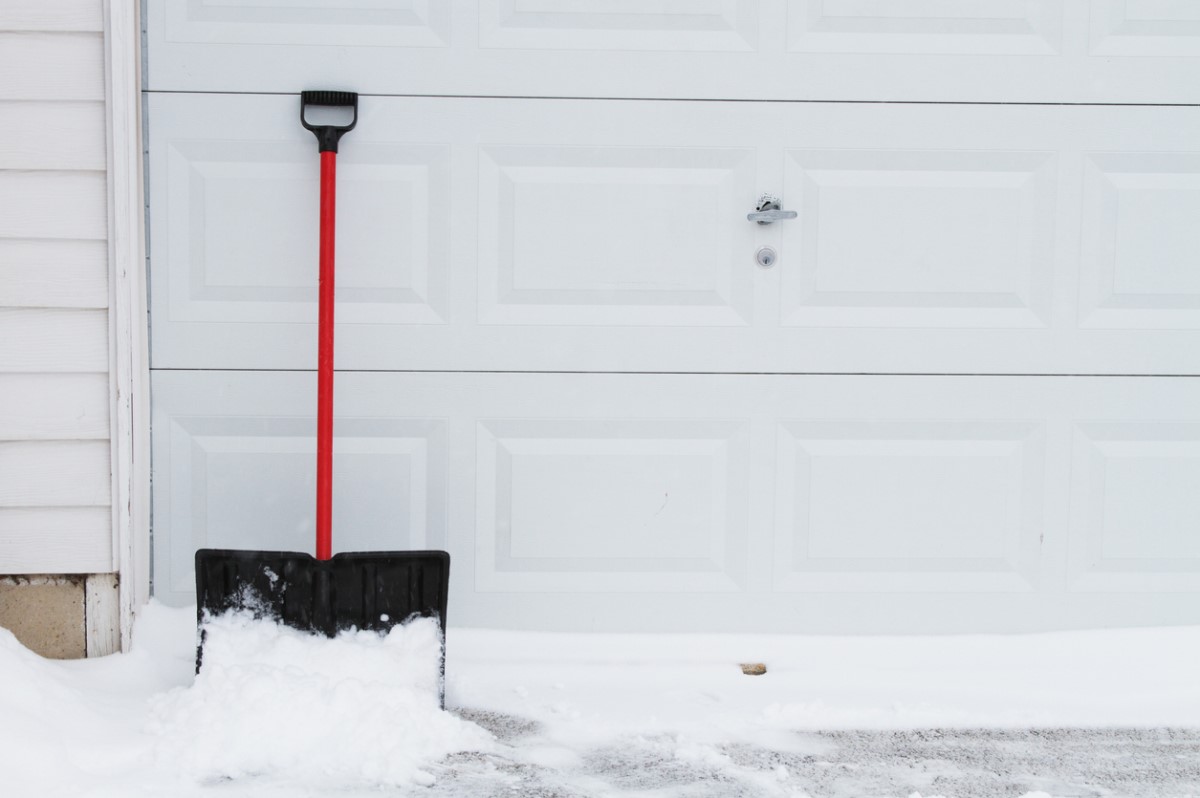

We may earn revenue from the products available on this page and participate in affiliate programs. Learn More ›
Shoveling snow is an onerous chore that can literally be a pain in the back, but for many folks it’s a necessity if they want to get the car out on the road. No wonder an increasingly popular cold-climate upgrade is a radiant heating system that’s installed just beneath a driveway’s surface to melt snow and ice. If you’re intrigued by the idea of keeping your driveway clear throughout the winter months, read on to learn how these systems work, what’s involved with their installation, and how much they cost.
RELATED: 9 Ways to Melt Ice Without Salt or Ice Melt
Why choose a heated driveway?
Installing radiant heat in outdoor slabs has been popular in commercial settings, such as restaurant walkways and mall parking lots, for more than 25 years; it started trending in residential applications about 15 years ago. Heated driveways are advantageous for homeowners who don’t have the time or the physical ability to remove snow by other means. If you live in a region that receives more than just a few light snowfalls during a typical winter, a heated driveway can save hours of shoveling.
Safety is also a big motivator. “Many people call us in because of the incline of their driveway,” says Richard English, a hydronic heating-certified licensed master plumber whose company, All-Island Radiant in Smithtown, New York, has been serving Long Island for more than 75 years. “They’ve had an incident, and it’s a safety issue.”
Choosing whether or not to install a heated driveway requires analyzing your needs and budget, and taking into account the type of winter you typically experience. Residential contractors in northern regions of the U.S. are beginning to install heated driveways in newly constructed houses as standard features. This trend is likely to increase in cold climates, particularly for homeowners who are trying to age in place.
RELATED: How Much Does a Heated Driveway Cost?
Electric vs. Hydronic Heating Systems

Homeowners can install either an electric system or a water-based (hydronic) system. Both hydronic and electric systems can be installed beneath a variety of driveway surfaces, including concrete, asphalt, and stone or brick pavers. Some of the major players in the snow-melt field are WarmZone and Uponor for hydronic, and WarmlyYours and ClearZone for electric.
In an electric system, heating cables or mats designed to resist damage and corrosion are embedded beneath the surface of the driveway. When these components heat up, snow and ice on the surface of the driveway melts. In a hydronic system, a solution of water and antifreeze circulates in a closed loop through resilient PEX tubing installed beneath the driveway’s surface. The liquid is heated by a boiler, usually housed in the garage.
Each of these systems has advantages and disadvantages, and one or the other may be more appropriate for a homeowner’s situation. Here are just a few pros and cons of each system:
- An electric driveway heating system costs less to install, in part because there’s no need to purchase a boiler to heat the water.
- Electric systems are typically more expensive to operate because they use more energy than hydronic systems, and electricity tends to be pricier than other options, such as natural gas.
- Electric systems are usually easier to repair than hydronic systems.
- The boiler for a hydronic system can be powered by natural gas, propane, electricity, or oil, so you can pick whichever option is cheapest in your area.
- An electric system for a very long driveway can require a surprising amount of electricity, which means you may need to upgrade your electrical panel before installation. (For a very long driveway, consider embedding just two rows of heating elements along the “tire tracks,” or opt for a hydronic system.)
- An electric snow-melt system can be retrofitted into asphalt or concrete driveways.
- Either type of system can be operated manually or automatically, and there are also Wi-Fi-connected systems.

Additional Considerations
Installing a heated driveway is an expensive proposition. Do your homework, and be aware that costs can add up: You’ll probably be ripping out an existing driveway, and you may need to buy a boiler or upgrade the electric panel. Then there’s the snow-melt system itself, including pipes or electric mats/cables, sensor(s), and a controller. Additional work may be required to correct drainage problems, and then finally, after the system is installed, you’ll need to put down a new driveway surface. For best results, English suggests working with an experienced contractor who specializes in radiant heat.
RELATED: The 20 Best Products for Surviving Winter

The Pros and Cons of Heated Driveways
Like all construction projects, installing a heated driveway comes with both benefits and drawbacks, and it is important to know what they are before investing in a radiant system.
PROS
- No more shoveling the driveway, which means no more pulled muscles, and numb fingers and toes.
- You’ll save money on professional snow-removal services, which, depending on the going rate in your community, could amount to $25 to $75 per hour for shoveling or about $450 for a seasonal contract.
- A heated driveway melts snow and ice safely without the use of ice-melt chemicals and salt that can harm the surface of the driveway, your landscape, your vehicles, and your pets’ paws.
- A driveway surface lasts longer if it’s not exposed to freezing temps and snow-melting products. When water from melted snow refreezes on a concrete driveway, it can lead to surface spalling and eventually to the development of cracks. By keeping the surface’s temperature above freezing, a snow-melt system can protect the integrity of the driveway.
- You won’t have to worry about family and visitors taking a fall on your icy driveway, and you’ll be less likely to be hit by a negligence lawsuit if someone slips and is injured.
- A heated driveway may increase the fair market value of your home, depending on where you live and how old the system is when you sell your house.
CONS
- A heated driveway won’t melt the snow and ice on steps or walkways, so you’ll either have to install radiant heat in those areas as well or be prepared to keep shoveling them.
- Installing a heated driveway usually involves tearing out the old driveway and putting down a new one, both of which add to the cost. Some electric systems can be retrofitted, and some contractors may be able to install a radiant heating system over an existing driveway. This method, however, may void the manufacturers’ warranties and should be used only when replacing a driveway is not a feasible option.
- Your utility bills will increase because you’ll be using more electricity or natural gas to operate the heated driveway. If you live in an area where utility costs are already high, you may find that it’s less expensive to just hire a snow-removal service.
- Putting in a heated driveway is a pricey proposition, and pro installation is required—you’ll need to hire a licensed contractor to do the work. If the existing driveway has to be removed, expect to pay $13,000 to $16,000 or more for the entire project, depending on the size of the driveway. Cut $3,000 to $5,000 from the bill if the driveway is small or if the radiant system is installed during new construction.
- If the heating system malfunctions, repairing it could entail tearing out part or all of the driveway. To reduce this risk, hire a reputable contractor and make sure you get a warranty. Standard warranties run from 10 to 20 years.
RELATED: We Tested the Best Snow Shovels, and Our Favorite Makes Lifting Heavy Snow Easier on Everyone
How to Maintain a Heated Driveway
Once a radiant system is installed, the driveway itself requires no special maintenance. For instance, you can drive and park consumer vehicles (including pickups) on all driveways, but to reduce the risk of cracking, it’s a good idea not to allow heavy vehicles, such as concrete mixer trucks, onto any driveway.
As long as it was installed by a reliable contractor, an electric driveway heating system should be maintenance-free. If you have a hydronic system, however, the boiler needs to be inspected once a year (or as specified in the warranty), typically in the fall.
RELATED: Repairing a Driveway? The Right Solution for Every Surface
Repairing a Heated Driveway
When installed correctly, a heated driveway should give you 15 to 20 years or more of dependable service, but like any mechanical system, it won’t last forever. Small repairs, such as replacing an electrical controller, could run as little as $350, but replacing a hydronic boiler could cost on average about $5,000. If the tubing in a hydronic system ruptures beneath the driveway, technicians can use a thermal imaging device to locate the leak, but a section of the driveway will have to be torn out to make repairs, which could cost over $1,000, depending on the size of the affected area. The warranty will detail which repairs are covered and which you will be on the hook for.
